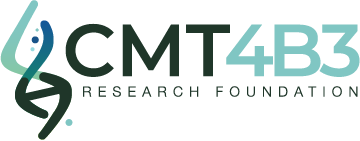
WHAT IS CMT4B3?
ONE GENE CHANGES EVERYTHING
(SBF1, MTMR5, DENND7A)
WHAT IS CMT4B3?
CMT4B3 is an ultra rare form of Charcot-Marie-Tooth Disease (CMT) which affects the peripheral nerves. Generally, there are about 100 different forms of CMT with varying degrees of severity, usually beginning in the third or fourth decade of one’s life. It is estimated that 1/2,500 people in the U.S. suffer from CMT and about 3 million worldwide. The same amount as Multiple Sclerosis (MS) and considerably more than Lou Gehrig Disease (ALS). CMT is the most common inherited peripheral nerve disorder that no one has ever heard of.
Hunter’s ultra-rare type of CMT, CMT4B3, is a severe early onset disorder which will cause the deterioration of his motor functions. There have only been 14 other documented patients with CMT4B3 worldwide. Peripheral nerves are tracts of nerve cell fibers that connect the brain and spinal cord to muscles and sensory organs. The axons inside the nerves will break down, which eventually causes the nerves to die, and the muscles they are connected to will waste away. This degenerative nerve disorder is characterized by progressive, irreversible wasting of the muscles, and gradual loss of function of the arms, hands, legs and feet, causing paralysis and possible blindness.
CMT4B3 was discovered in 2013. CMT4B3 is caused by a genetic mutation of the SBF1 gene on chromosome 22, which is responsible for producing the MTMR5 protein. The MTMR5 protein is a catalytically inactive member of the myotubularin protein family. Mutations of the genes encoding for myotubularin proteins have been associated with many diseases, including CMT4B1 and CMT4B2. Very little is currently known about CMT4B3.
KNOWN SYMPTOMS OF CMT4B3
The phenotype varies among the known CMT4B3 patients. CMT4B3 symptoms include, but are not limited to:
Microcephaly
Strabismus
Cognitive Delay
Brain Atrophy
Intellectual Impairment
Limb Weakness
Muscle Weakness
Sensory Loss
Loss of Deep Tendon Reflexes
Reduced Action Potential Amplitude
Decreased Nerve Conduction Velocity
Fibrillation
Depleted Myelinated Axons
Focally Folded Myelin Sheaths
Spine Disorders
Scoliosis
Lumbar Hyperlordosis
Kyphoscoliosis
Short Stature
Gait Difficulties
Pes Cavus
Pes Planus
Drop-foot
Joint Laxity / Thumb Sign
Syndactyly
Complex Cranial Nerve involvement
Astigmatism
Gynecomastia
Hearing Loss
Nystagmus
Strabismus
Ophthalmoparesis
Absent Pupil Reactivity
Facial Weakness
Tongue Weakness
Abnormal gag reflex
Dysarthria
Dysphagia
Oromandibular Dystonia
Gynecomastia
Elongated Face / Wide Philtrum
Respiratory Involvement
Urinary incontinence
HOW DO YOU GET CMT4B3?
All subtypes of CMT4 are inherited in an autosomal recessive pattern. An autosomal recessive disorder occurs when a child inherits two copies of a mutated gene, one from the mother and one from the father. The biological parents often have no symptoms of disease because the one functional gene is able to compensate for the defective gene. Two parents that are carriers have a 25% chance of having an unaffected child with two normal genes (left), a 50% chance of having an unaffected child who also is a carrier (middle), and a 25% chance of having an affected child with two recessive genes (right).
Our funding and grants will facilitate scientists, labs and universities to research and understand the function and relationship between the loss of protein and Hunter’s disease. Our hope is that the more we learn about the disease, the more effective treatments will be not only for Hunter, but for others suffering from rare and peripheral nerve disorders.
SCIENTIFIC DETAILS
HGNC Approved Gene Symbol: SBF1
Cytogenetic location: 22q13.33
Genomic coordinates (GRCh38): 22:50,444,999-50,475,034 (from NCBI)
CMT4B3 is an autosomal recessive disease caused by homozygous or compound heterozygous mutation in the SBF1 gene (603560) on chromosome 22q. Some myotubular proteins (MTMR) members contain catalytically inactive phosphatase domains, and thus, they belong to a subgroup called “pseudophosphatases” (i.e. MTMR5 and MTMR13). Studies suggested that MTMR5 and MTMR13 interact with MTMR2 directly via their coiled-coil domains (between the phosphatase domain and the PH domain), increasing the phosphatase activity of MTMR2 as well as commanding its subcellular localization. Phosphatases; myotubular proteins (MTMRs) possess 3-phosphatase activity toward both PtdIns3P and PtdIns (3,5)P 2 poliphosphoinositides (PPIn).
In the grand scheme of CMT, these three MTMR proteins are important in the vesicle trafficking pathway within neuronal cells, and cells that create the myelin sheaths – Schwann cells and oligodendrocytes. The vesicle trafficking pathway is a vital process that helps move proteins within the cell, out of the cell, as well as taking in proteins and other things from the outside. MTMR5 and MTMR13 are homologues which share 59% overall sequence identity. As MTMR5 is the closest homologue of MTMR13, it is possible that the loss of function in MTMR5 could also induce dysfunction in neuronal or Schwann cells via a similar mechanism with the MTMR2/MTMR13 complex. This may explain the strikingly similar phenotypes of patients with recessive mutations in the MTMR2, SBF2, and SBF1 genes.


